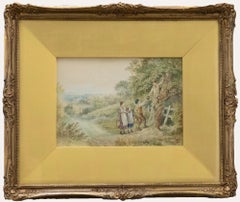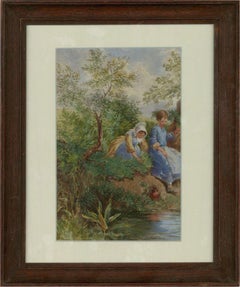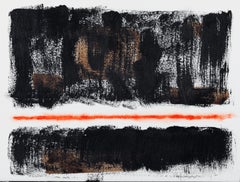Myles Birket Foster Drawings and Watercolor Paintings
Myles Birket Foster was a popular English illustrator, watercolor artist and engraver in the Victorian period. His name is also to be found as Myles Birkett Foster. Foster was born in North Shields, England of a primarily Quaker family, but his family moved south to London in 1830, where his father founded M. B. Foster & sons — a successful beer-bottling company. He was schooled at Hitchin, Hertfordshire and on leaving, he initially went into his father's business. However, noticing his talent for art, his father secured an apprenticeship with the notable wood engraver, Ebenezer Landells, where he worked on illustrations for Punch magazine and the Illustrated London News. On leaving Landells' employ, he continued to produce work for the Illustrated London News and the Illustrated London Almanack. He also found work as a book illustrator and, during the 1850s, trained himself to paint in watercolors. His illustrations of Longfellow’s Evangeline and books of poetry by other contemporaries were a great success, and he quickly became a successful artist in watercolors. Foster became an Associate of the "Old" Watercolor Society (Later the Royal Watercolor Society) in 1860 and exhibited some 400 of his paintings at the Royal Academy of Arts for over more than two decades. He traveled widely, painting the countryside around Scotland, the Rhine Valley, the Swiss lakes and in Italy, especially Venice. In 1863, he moved to Witley, near Godalming in Surrey, where he had a house named The Hill built. Being friendly with Edward Burne-Jones and William Morris, he had the house decorated and furnished in contemporary style, with tiles and paintings by Burne-Jones and Morris' firm, Morris and Company. The same year, he published a volume of English Landscapes, with text by Tom Taylor. Although he had painted great numbers of landscape scenes from Scotland to the Mediterranean, it was after moving to Witley that Birket Foster produced the works for which he is best known—a sentimentalized view of the contemporary English countryside, particularly in the West Surrey area. Although criticized for their idealized view of rural life, they were recognized for their detail and execution. Foster's work (along with that of other artists) was used by Cadbury, the chocolate manufacturer, on the cover of their chocolate boxes from the 1860s onwards. He became ill in 1893 and moved to Weybridge. He continued painting but died on 27th March 1899. His obituary in The Times referred to him as "certainly the most popular watercolor artist of our time." He is buried at All Saints' Church in Witley.
20th Century Myles Birket Foster Drawings and Watercolor Paintings
Watercolor
1860s Myles Birket Foster Drawings and Watercolor Paintings
Watercolor
Late 19th Century Myles Birket Foster Drawings and Watercolor Paintings
Watercolor
20th Century Myles Birket Foster Drawings and Watercolor Paintings
Watercolor, Pencil
2010s Bauhaus Myles Birket Foster Drawings and Watercolor Paintings
Ink, Acrylic, Watercolor
1940s Myles Birket Foster Drawings and Watercolor Paintings
Paper, Crayon, Pastel, Gouache, Pencil
21st Century and Contemporary Abstract Geometric Myles Birket Foster Drawings and Watercolor Paintings
Watercolor
16th Century Old Masters Myles Birket Foster Drawings and Watercolor Paintings
Ink, Gouache, Pen
19th Century Romantic Myles Birket Foster Drawings and Watercolor Paintings
Watercolor
1910s Naturalistic Myles Birket Foster Drawings and Watercolor Paintings
India Ink, Paper, Watercolor
Gustav MelcherGustav Melcher ( German, 1898 -?) Boats off Venice Italy Ink Water Color c. 1918, 1918
Late 20th Century Abstract Expressionist Myles Birket Foster Drawings and Watercolor Paintings
Paper, India Ink, Gouache
21st Century and Contemporary Impressionist Myles Birket Foster Drawings and Watercolor Paintings
Watercolor, Archival Paper
19th Century Romantic Myles Birket Foster Drawings and Watercolor Paintings
Watercolor
19th Century Old Masters Myles Birket Foster Drawings and Watercolor Paintings
Watercolor, Pencil
16th Century Old Masters Myles Birket Foster Drawings and Watercolor Paintings
Paper, Gouache



